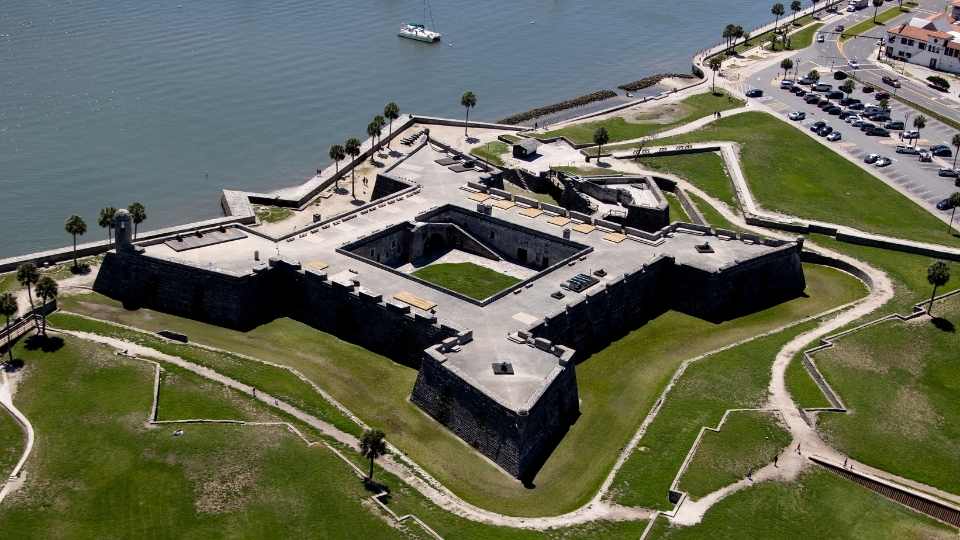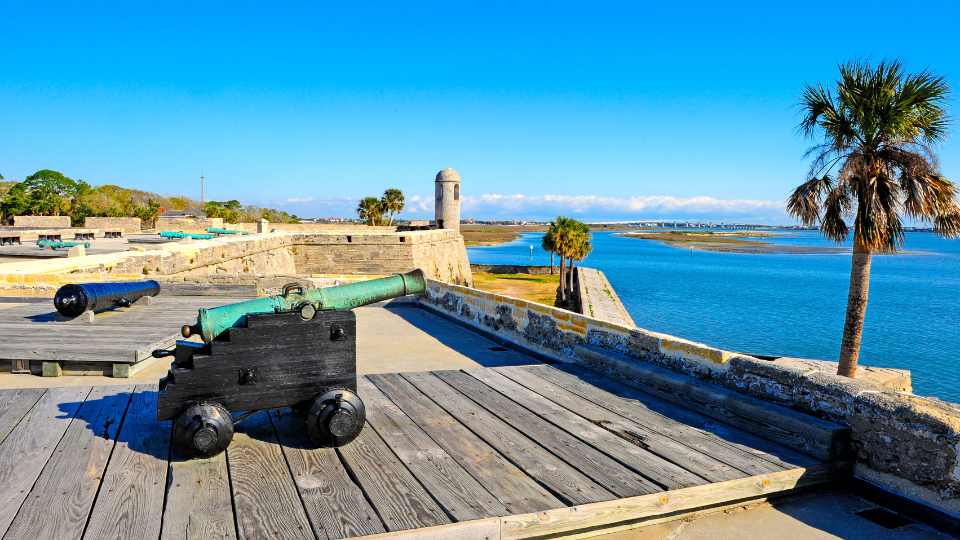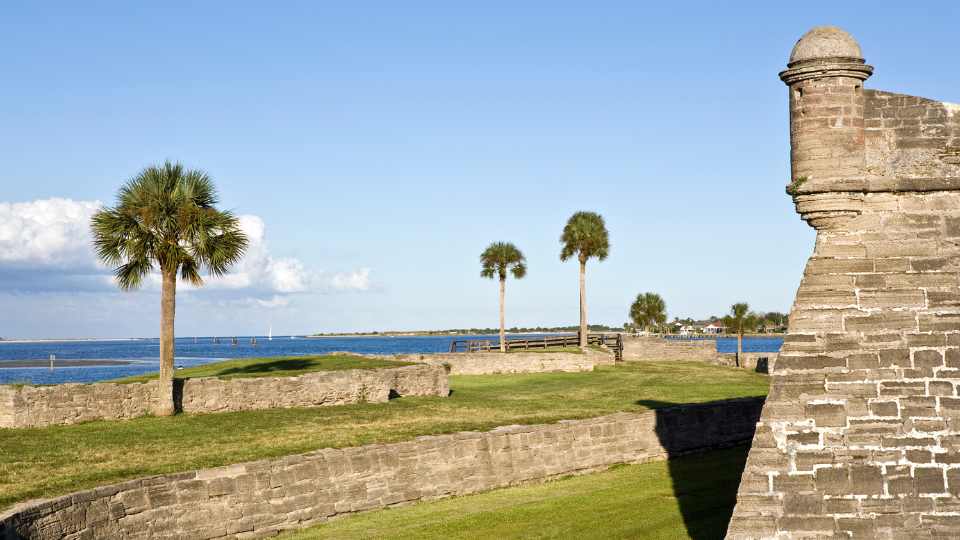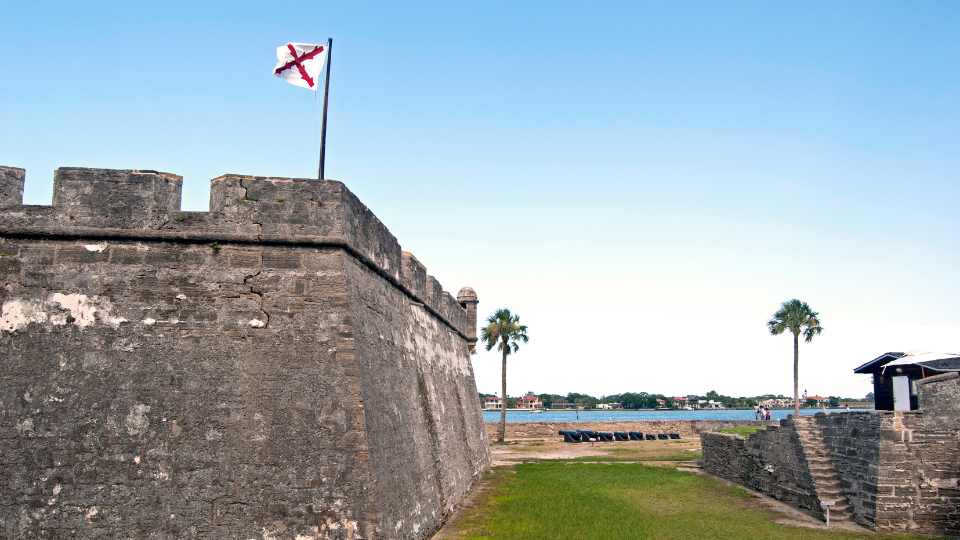
The Castillo de San Marcos stands as a monumental piece of history in St. Augustine, Florida, representing over four centuries of cultural exchange and military strategy. Constructed by the Spanish during a time of imperial expansion, this masonry fort personifies the clash and blend of civilizations that have shaped the region. The stone walls of Castillo de San Marcos, which have endured battles and sieges, testify to the fortress’s strategic importance in protecting Spanish interests along the Atlantic trade route.
As the oldest masonry fortification in the continental United States, its architecture and design offer a glimpse into 17th-century military engineering. The fort’s star-shaped design coupled with its ability to withstand sieges speaks to a larger story of resilience and adaptation. Over the years, Castillo de San Marcos has changed hands between different powers, serving as a military post under the Spanish, British, and later the United States Army, before ultimately being designated a National Monument.
Key Takeaways
- Castillo de San Marcos is the oldest masonry fort in the continental United States and represents significant historical and cultural eras.
- Its strategic importance is underscored by its design and the role it played in protecting trade routes and territorial claims.
- The site is an enduring symbol of resilience, maintaining its integrity through centuries and serving as a historical landmark for visitors.
Historical Context
The Castillo de San Marcos stands as a testament to the tumultuous colonial history of Florida, providing insight into the periods of European struggle over the New World and the evolving military narrative of the United States through subsequent conflicts.
Spanish Empire and St. Augustine
The establishment of St. Augustine in 1565 marked a strategic move by the Spanish Empire to strengthen their claim in the New World. Recognizing the need for defensible structures against threats such as English privateer Sir Francis Drake who sacked the town in 1586, construction of the Castillo de San Marcos commenced in 1672. The fort was completed in 1695, and over the years, became a pivotal guardian over the treacherous Florida coast, safeguarding the Spanish treasure ships routed from the Caribbean to the Old World.
Colonial Conflicts and Ownership Changes
During its history, Castillo de San Marcos has witnessed various conflicts and ownership changes reflective of the broader geopolitical dynamics. Following the Spanish success against a British siege in 1702, the fort stood as a symbol of imperial endurance. However, the tides changed with the Treaty of Paris (1763), which ended the Seven Years’ War and transferred Florida to British control. When the American Revolution erupted, the British held the fort until the second Treaty of Paris in 1783, when control reverted to Spain. The fortress, known as Fort Marion during the 19th century, again changed hands after Florida became a U.S. territory in 1821.
Civil War and Changing Uses
Castillo de San Marcos was renamed Fort Marion in 1825 and played various military roles including during the Civil War, when it was occupied by Confederate forces until falling under Union control in 1862. As conflict evolved on the continent, so did the fort’s utilization. Post Civil War, it served as a prison, notably for Native Americans during the Seminole Wars and for Union deserters. After a brief occupancy during the Spanish-American War, the site was declared a national monument in 1924, securing its legacy as a relic of 17th-century military architecture and a guardian of American heritage.

Architecture and Design
The Castillo de San Marcos reflects the culmination of hundreds of years of military defense engineering, standing as a prominent structure of historical and architectural importance in St. Augustine, Florida.
Masonry Fort Construction
Castillo de San Marcos is a striking national monument recognized for its masonry fort construction. Its walls are made predominantly of coquina, a type of limestone consisting of broken shells, which has proven to be an unexpectedly resilient material. Coquina was sourced from local quarries and used extensively throughout the Castillo, owing to its durability and the comparative scarcity of other building resources.
Defensive Features and Bastion System
This stone fort was designed using the bastion system, an innovation that marked a significant advance in military architecture. The fort’s star-shaped design includes four diamond-shaped bastions, strategically positioned to provide overlapping fields of fire. Each bastion was capable of mounting cannons, giving the Castillo a formidable defensive reach against any approaching enemy. The bastion system allowed defenders to cover all angles of approach, making the fortress nearly impregnable to assaults from the sea and land.
Expansion and Renovation
Throughout its history, the Castillo de San Marcos underwent various phases of expansion and renovation to adapt to evolving military technologies and tactics. Notably, during its time as Fort Marion, the fort was modernized in response to these changing demands. Engineers continuously improved the fort’s design, reinforcing its walls and upgrading its masonry fortifications to provide enduring protection against attacks, including those involving cannonballs. The persistent maintenance and renovation have preserved the Castillo as one of the oldest masonry fortresses in North America and a timeless witness to centuries of martial innovation.

Cultural Significance
The Castillo de San Marcos National Monument serves as a pivotal piece of American history, reflecting a complex tapestry of cultural interactions and military conflicts that shaped the nation.
As a National Monument
Castillo de San Marcos, designated a National Monument by the National Park Service, stands as the oldest masonry fort in the continental United States. It’s a testament to the Spanish empire’s influence in North America, surviving multiple sieges and serving various military purposes throughout its existence. Today, it is a prominent tourist destination, offering a glimpse into the country’s colonial past.
Educational Programs and Demonstrations
Throughout the year, the National Monument is alive with educational programs and demonstrations that offer insight into life during various periods of the fort’s history. Re-enactors perform military demonstrations, illustrating historical tactics and the use of firearms and cannons. Additionally, educational talks are held about the Castillo’s role as a military prison for Native Americans, including during the Seminole Wars.
Influence on Local and National Narratives
The Castillo de San Marcos National Monument has influenced local and national narratives, particularly through its connection to key historical moments such as the Civil Rights Movement. Figures like Robert Hayling and Hosea Williams are associated with St. Augustine, linking the fortress to the broader struggle against segregation. The monument’s existence through periods including the enactment of the Civil Rights Act of 1964 makes it a symbol of endurance and transformation. As changes in seasons, including summer, bring a shift in activities and visiting patterns, the Castillo remains a steadfast reminder of past conflicts and cultural exchanges.

Surviving the Centuries
Castillo de San Marcos, a prominent historical landmark in the United States, exemplifies architectural resilience and preservation efforts that have allowed it to endure through a myriad of natural and man-made hazards since its completion in the late 17th century.
Restoration and Preservation
The fort, initially named Fort Marion, was designated as a national monument in 1924, signifying formal recognition of its historical significance and the need for its preservation. Restoration efforts are continuous to address concerns like the large cracks that have appeared in the walls. Utilizing coquina, a sedimentary rock composed of shell fragments, for the fort’s construction has been pivotal in its longevity. This unique material has shown remarkable resilience and gives insight into the restoration practices that are essential to preserving the Castillo’s exterior for future generations.
Resilience to Natural and Human Threats
Throughout its history, Castillo de San Marcos has withstood numerous threats. Its durable coquina walls survived the fire set by English forces during the siege of 1702, where it was notably the only edifice in St. Augustine that endured. Moreover, the fort has faced environmental threats like erosion and storms, typical of Florida’s coastal regions. Its strategic military use extended into the 20th century when it served as a monitoring station for U-boat activities during World War II. These instances highlight the structure’s resilience and underscore America’s adaptive reuse of historical sites to meet contemporary needs.

Visiting Castillo de San Marcos
When planning a trip to Castillo de San Marcos, the oldest masonry fort in the continental United States, visitors should consider touring schedules, accessibility options, and nearby attractions to maximize their experience at this historic site in St. Augustine, Florida.
Planning Your Visit
To make the most of a visit, it’s recommended to check the National Park Service website for the Castillo de San Marcos for the latest updates on hours of operation and possible events. The fort provides a glimpse into America’s past, with exhibits that tell the stories of historical figures such as the Seminole leader Osceola. Adults and children alike can explore the fort’s bastions, view canons, and gaze out of the guardrooms’ windows.
Touring the Monument:
- Availability: Open year-round; closed on December 25th
- Best time to visit: Earlier in the day to avoid crowds
Amenities and Accessibility
Castillo de San Marcos ensures a welcoming experience for all visitors, with accessibility being a priority. Wheelchair users can access the ground level of the fort, including the theater and bookstore.
Facilities at the Site:
- Restrooms: Available on site
- Parking: Limited parking available, additional parking around St. Augustine
- Wheelchair Rental: Not provided; visitors must bring their own
Nearby Attractions
The fort overlooks the picturesque Anastasia Island, making it an ideal spot for taking memorable photos. Anastasia State Park is a short drive away, offering sandy beaches and natural beauty. In the city, other historical points of interest, such as the pirate museum, reflect the tales of raiders like Robert Searles.
Points of Interest:
- Anastasia State Park: Beaches and nature trails
- Historical Museums: Insights into the cultural heritage of Florida
- Dining and Shopping: A variety of options available in downtown St. Augustine
Visitors to Castillo de San Marcos National Monument will not only step back in time to an era of battles and legends but will also enjoy modern comforts and conveniences to enhance their educational and leisure experience.
